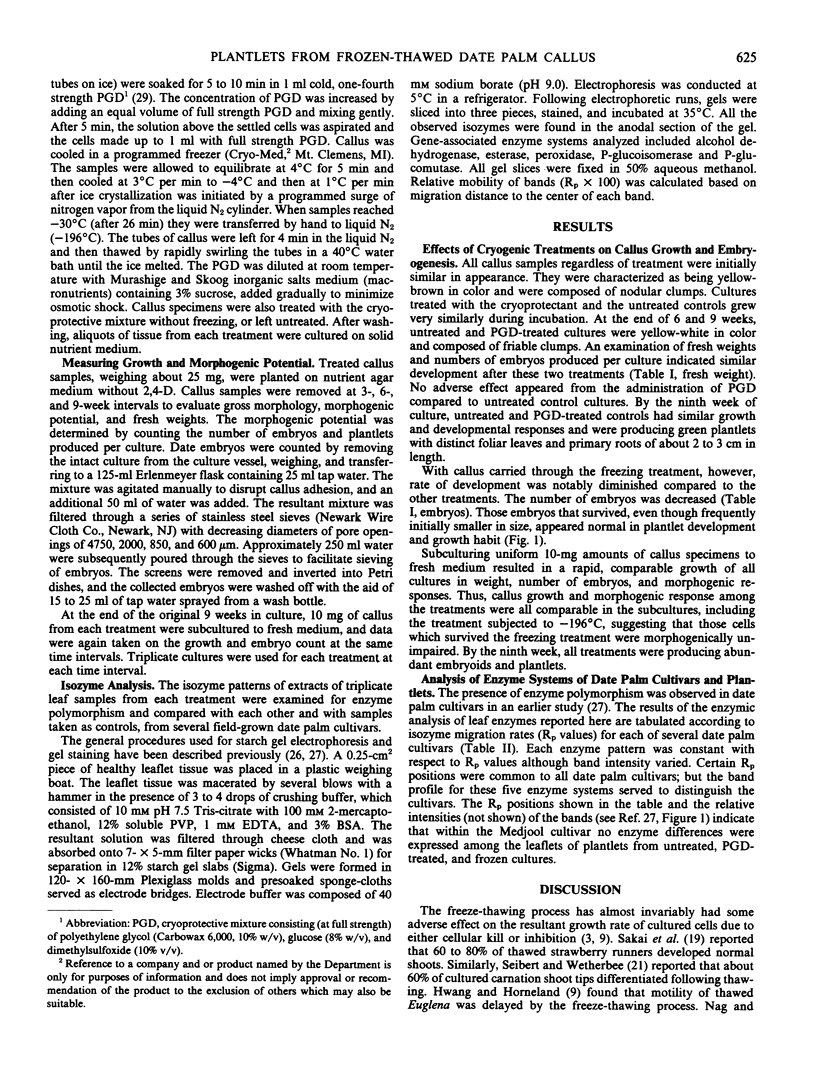Abstract
Embryogenic date palm (Phoenix dactylifera L. var. Medjool) callus cultures were treated with a cryoprotective mixture of polyethylene glycol (Carbowax 6000), glucose, and dimethylsulfoxide (10%/8%/10%, w/v); treated with the mixture, frozen to −196°C, and then thawed; or left untreated. Growth subsequent to treatment was measured as fresh weight increase and as the number of embryos produced during 18 weeks of culture. The growth of calli that were frozen and thawed, compared to the other treatments, was greatly inhibited during the first 9 weeks of culture. This inhibition disappeared in subcultured tissue. In all treatments, cultures initiated plantlets after 9 weeks. Enzyme polymorphism, for five gene-associated enzyme systems including alcohol dehydrogenase, esterase, peroxidase, phosphoglucomutase, and phosphoglucoisomerase, was analyzed in leaves of regenerated plantlets by using starch gel electrophoresis for separation. Isozyme patterns were similar for all treatments.
Full text
PDF



Images in this article
Selected References
These references are in PubMed. This may not be the complete list of references from this article.
- Ashwood-Smith M. J., Friedmann G. B. Lethal and chromosomal effects of freezing, thawing, storage time, and x-irradiation on mammalian cells preserved at -196 degrees in dimethyl sulfoxide. Cryobiology. 1979 Apr;16(2):132–140. doi: 10.1016/0011-2240(79)90023-3. [DOI] [PubMed] [Google Scholar]
- Ashwood-Smith M. J., Grant E. Mutation induction in bacteria by freeze-drying. Cryobiology. 1976 Apr;13(2):206–213. doi: 10.1016/0011-2240(76)90134-6. [DOI] [PubMed] [Google Scholar]
- Finkle B. J., Ulrich J. M. Effects of cryoprotectants in combination on the survival of frozen sugarcane cells. Plant Physiol. 1979 Apr;63(4):598–604. doi: 10.1104/pp.63.4.598. [DOI] [PMC free article] [PubMed] [Google Scholar]
- Hwang S. W., Horneland W. Survival of algal cultures after freezing by controlled and uncontrolled cooling. Cryobiology. 1965 May-Jun;1(5):305–311. doi: 10.1016/0011-2240(65)90070-2. [DOI] [PubMed] [Google Scholar]
- Lee D. W., Dougall D. K. Electrophoretic variation in glutamate dehydrogenase and other isozymes in wild carrot cells cultured in the presence and absence of 2,4-dichlorophenoxyacetic acid. In Vitro. 1973 Mar-Apr;8(5):347–352. doi: 10.1007/BF02619059. [DOI] [PubMed] [Google Scholar]
- Quatrano R. S. Freeze-preservation of cultured flax cells utilizing dimethyl sulfoxide. Plant Physiol. 1968 Dec;43(12):2057–2061. doi: 10.1104/pp.43.12.2057. [DOI] [PMC free article] [PubMed] [Google Scholar]
- Sakai A. Survival of Plant Tissue at Super-Low Temperature III. Relation between Effective Prefreezing Temperatures and the Degree of Front Hardiness. Plant Physiol. 1965 Sep;40(5):882–887. doi: 10.1104/pp.40.5.882. [DOI] [PMC free article] [PubMed] [Google Scholar]
- Sakai A., Yoshida S. Survival of Plant Tissue at Super-Low Temperature VI. Effects of Cooling and Rewarming Rates on Survival. Plant Physiol. 1967 Dec;42(12):1695–1701. doi: 10.1104/pp.42.12.1695. [DOI] [PMC free article] [PubMed] [Google Scholar]
- Seibert M., Wetherbee P. J. Increased Survival and Differentiation of Frozen Herbaceous Plant Organ Cultures through Cold Treatment. Plant Physiol. 1977 Jun;59(6):1043–1046. doi: 10.1104/pp.59.6.1043. [DOI] [PMC free article] [PubMed] [Google Scholar]
- Ulrich J. M., Finkle B. J., Moore P. H., Ginoza H. Effect of a mixture of cryoprotectants in attaining liquid nitrogen survival of callus cultures of a tropical plant. Cryobiology. 1979 Dec;16(6):550–556. doi: 10.1016/0011-2240(79)90073-7. [DOI] [PubMed] [Google Scholar]



